tow VAUXHALL MOVANO_B 2020 Owner's Manual
[x] Cancel search | Manufacturer: VAUXHALL, Model Year: 2020, Model line: MOVANO_B, Model: VAUXHALL MOVANO_B 2020Pages: 351, PDF Size: 9.32 MB
Page 17 of 351
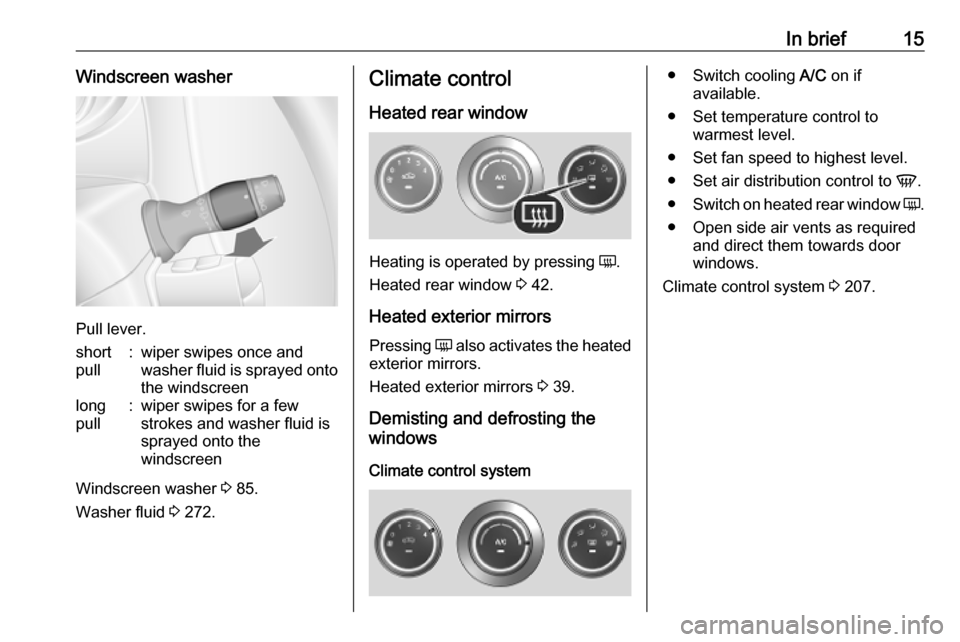
In brief15Windscreen washer
Pull lever.
short
pull:wiper swipes once and
washer fluid is sprayed onto
the windscreenlong
pull:wiper swipes for a few strokes and washer fluid is
sprayed onto the
windscreen
Windscreen washer 3 85.
Washer fluid 3 272.
Climate control
Heated rear window
Heating is operated by pressing Ü.
Heated rear window 3 42.
Heated exterior mirrors
Pressing Ü also activates the heated
exterior mirrors.
Heated exterior mirrors 3 39.
Demisting and defrosting the
windows
Climate control system
● Switch cooling A/C on if
available.
● Set temperature control to warmest level.
● Set fan speed to highest level.
● Set air distribution control to V.
● Switch on heated rear window Ü.
● Open side air vents as required and direct them towards door
windows.
Climate control system 3 207.
Page 20 of 351
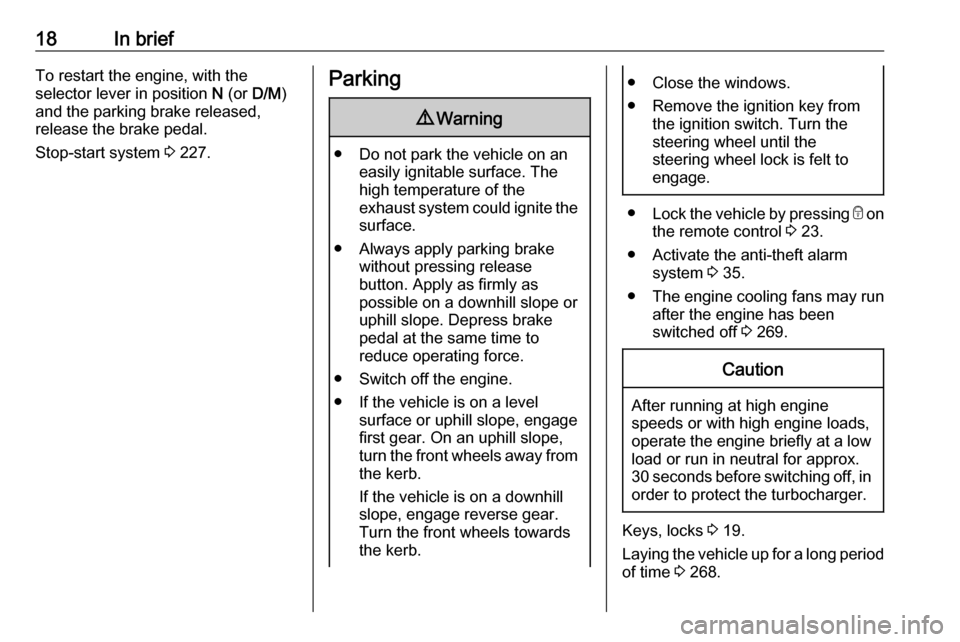
18In briefTo restart the engine, with the
selector lever in position N (or D/M )
and the parking brake released, release the brake pedal.
Stop-start system 3 227.Parking9 Warning
● Do not park the vehicle on an
easily ignitable surface. The
high temperature of the
exhaust system could ignite the
surface.
● Always apply parking brake without pressing release
button. Apply as firmly as
possible on a downhill slope or
uphill slope. Depress brake
pedal at the same time to
reduce operating force.
● Switch off the engine.
● If the vehicle is on a level surface or uphill slope, engage
first gear. On an uphill slope,
turn the front wheels away from
the kerb.
If the vehicle is on a downhill
slope, engage reverse gear.
Turn the front wheels towards the kerb.
● Close the windows.
● Remove the ignition key from the ignition switch. Turn the
steering wheel until the
steering wheel lock is felt to
engage.
● Lock the vehicle by pressing e on
the remote control 3 23.
● Activate the anti-theft alarm system 3 35.
● The engine cooling fans may run
after the engine has been
switched off 3 269.
Caution
After running at high engine
speeds or with high engine loads,
operate the engine briefly at a low load or run in neutral for approx.30 seconds before switching off, in
order to protect the turbocharger.
Keys, locks 3 19.
Laying the vehicle up for a long period
of time 3 268.
Page 31 of 351
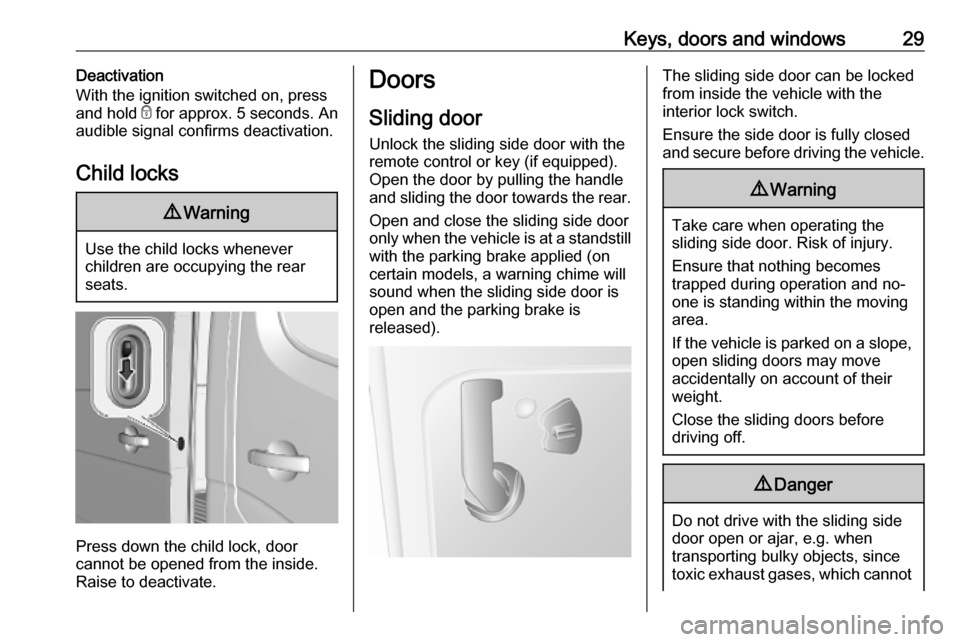
Keys, doors and windows29Deactivation
With the ignition switched on, press
and hold e for approx. 5 seconds. An
audible signal confirms deactivation.
Child locks9 Warning
Use the child locks whenever
children are occupying the rear
seats.
Press down the child lock, door
cannot be opened from the inside.
Raise to deactivate.
Doors
Sliding door
Unlock the sliding side door with the remote control or key (if equipped).
Open the door by pulling the handle
and sliding the door towards the rear.
Open and close the sliding side door
only when the vehicle is at a standstill with the parking brake applied (on
certain models, a warning chime will
sound when the sliding side door is
open and the parking brake is
released).The sliding side door can be locked
from inside the vehicle with the
interior lock switch.
Ensure the side door is fully closed
and secure before driving the vehicle.9 Warning
Take care when operating the
sliding side door. Risk of injury.
Ensure that nothing becomes
trapped during operation and no-
one is standing within the moving
area.
If the vehicle is parked on a slope,
open sliding doors may move
accidentally on account of their
weight.
Close the sliding doors before
driving off.
9 Danger
Do not drive with the sliding side
door open or ajar, e.g. when
transporting bulky objects, since
toxic exhaust gases, which cannot
Page 47 of 351
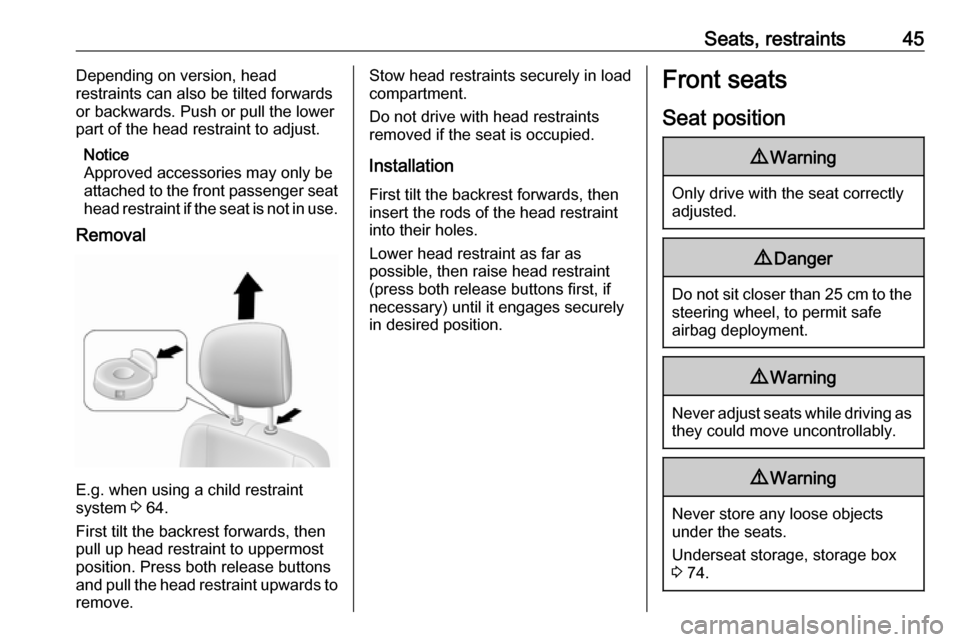
Seats, restraints45Depending on version, head
restraints can also be tilted forwards
or backwards. Push or pull the lower
part of the head restraint to adjust.
Notice
Approved accessories may only be
attached to the front passenger seat
head restraint if the seat is not in use.
Removal
E.g. when using a child restraint
system 3 64.
First tilt the backrest forwards, then
pull up head restraint to uppermost
position. Press both release buttons
and pull the head restraint upwards to remove.
Stow head restraints securely in load
compartment.
Do not drive with head restraints
removed if the seat is occupied.
Installation First tilt the backrest forwards, then
insert the rods of the head restraint into their holes.
Lower head restraint as far as
possible, then raise head restraint (press both release buttons first, if
necessary) until it engages securely
in desired position.Front seats
Seat position9 Warning
Only drive with the seat correctly
adjusted.
9 Danger
Do not sit closer than 25 cm to the
steering wheel, to permit safe
airbag deployment.
9 Warning
Never adjust seats while driving as
they could move uncontrollably.
9 Warning
Never store any loose objects
under the seats.
Underseat storage, storage box 3 74.
Page 54 of 351
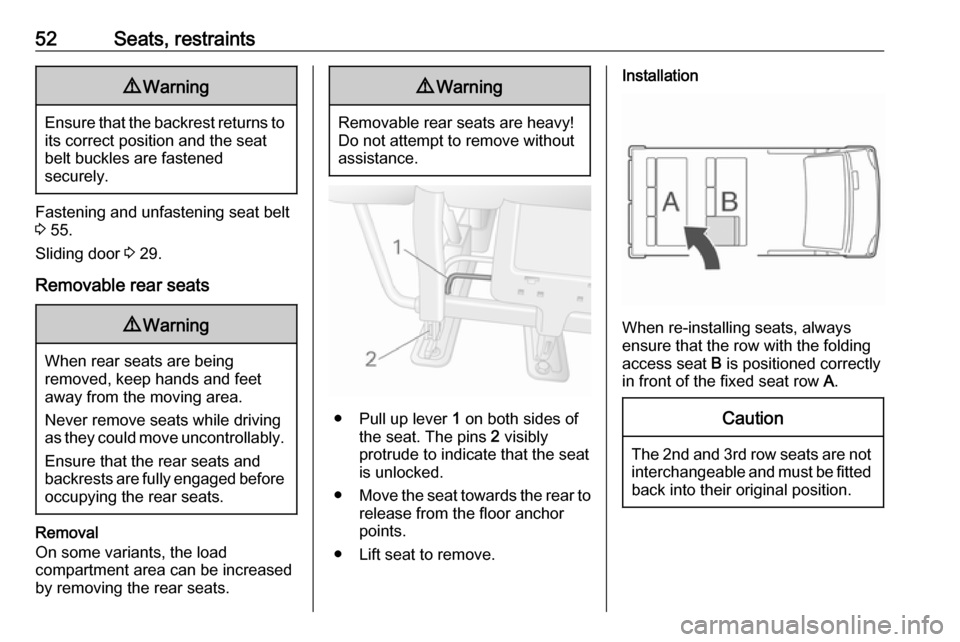
52Seats, restraints9Warning
Ensure that the backrest returns to
its correct position and the seat
belt buckles are fastened
securely.
Fastening and unfastening seat belt 3 55.
Sliding door 3 29.
Removable rear seats
9 Warning
When rear seats are being
removed, keep hands and feet
away from the moving area.
Never remove seats while driving
as they could move uncontrollably.
Ensure that the rear seats and
backrests are fully engaged before occupying the rear seats.
Removal
On some variants, the load
compartment area can be increased by removing the rear seats.
9 Warning
Removable rear seats are heavy!
Do not attempt to remove without assistance.
● Pull up lever 1
on both sides of
the seat. The pins 2 visibly
protrude to indicate that the seat is unlocked.
● Move the seat towards the rear to
release from the floor anchor
points.
● Lift seat to remove.
Installation
When re-installing seats, always
ensure that the row with the folding
access seat B is positioned correctly
in front of the fixed seat row A.
Caution
The 2nd and 3rd row seats are not
interchangeable and must be fitted back into their original position.
Page 56 of 351
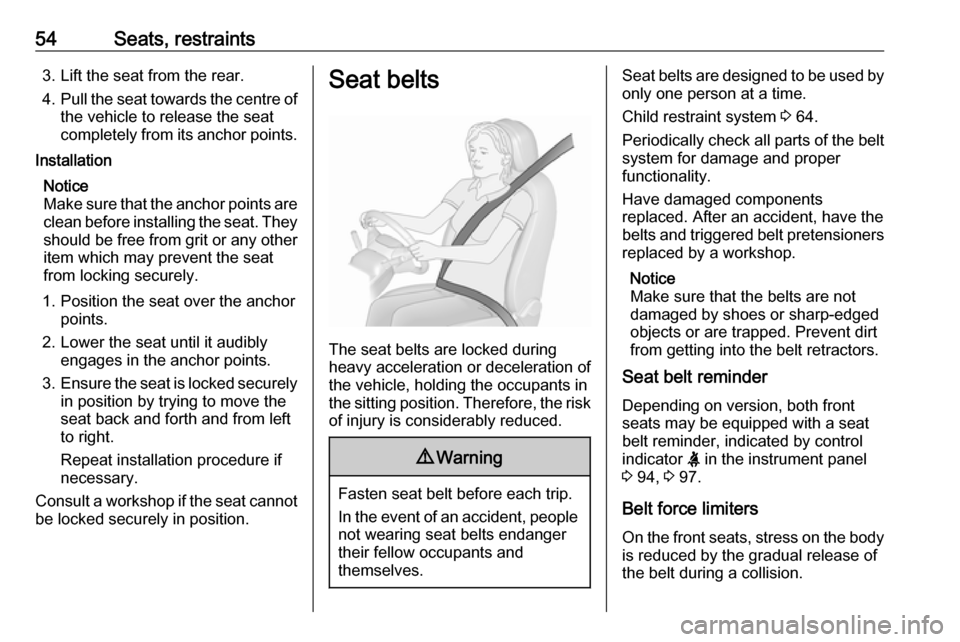
54Seats, restraints3. Lift the seat from the rear.
4. Pull the seat towards the centre of
the vehicle to release the seat
completely from its anchor points.Installation
Notice
Make sure that the anchor points are
clean before installing the seat. They should be free from grit or any other
item which may prevent the seat
from locking securely.
1. Position the seat over the anchor points.
2. Lower the seat until it audibly engages in the anchor points.
3. Ensure the seat is locked securely
in position by trying to move the
seat back and forth and from left
to right.
Repeat installation procedure if
necessary.
Consult a workshop if the seat cannot
be locked securely in position.Seat belts
The seat belts are locked during
heavy acceleration or deceleration of
the vehicle, holding the occupants in
the sitting position. Therefore, the risk of injury is considerably reduced.
9 Warning
Fasten seat belt before each trip.
In the event of an accident, people
not wearing seat belts endanger their fellow occupants and
themselves.
Seat belts are designed to be used by only one person at a time.
Child restraint system 3 64.
Periodically check all parts of the belt
system for damage and proper
functionality.
Have damaged components
replaced. After an accident, have the
belts and triggered belt pretensioners replaced by a workshop.
Notice
Make sure that the belts are not
damaged by shoes or sharp-edged
objects or are trapped. Prevent dirt
from getting into the belt retractors.
Seat belt reminder
Depending on version, both front
seats may be equipped with a seat
belt reminder, indicated by control
indicator X in the instrument panel
3 94, 3 97.
Belt force limiters
On the front seats, stress on the body is reduced by the gradual release of
the belt during a collision.
Page 62 of 351

60Seats, restraintsføre til at BARNET utsettes for
LIVSFARE og fare for ALVORLIGE
SKADER.
PT: NUNCA use um sistema de
retenção para crianças voltado para
trás num banco protegido com um
AIRBAG ACTIVO na frente do
mesmo, poderá ocorrer a PERDA DE VIDA ou FERIMENTOS GRAVES na
CRIANÇA.
IT: Non usare mai un sistema di
sicurezza per bambini rivolto
all'indietro su un sedile protetto da
AIRBAG ATTIVO di fronte ad esso:
pericolo di MORTE o LESIONI
GRAVI per il BAMBINO!
EL: ΠΟΤΕ μη χρησιμοποιείτε παιδικό
κάθισμα ασφαλείας με φορά προς τα πίσω σε κάθισμα που προστατεύεται
από μετωπικό ΕΝΕΡΓΟ ΑΕΡΟΣΑΚΟ, διότι το παιδί μπορεί να υποστεί
ΘΑΝΑΣΙΜΟ ή ΣΟΒΑΡΟ
ΤΡΑΥΜΑΤΙΣΜΟ.
PL: NIE WOLNO montować fotelika
dziecięcego zwróconego tyłem do
kierunku jazdy na fotelu, przed
którym znajduje się WŁĄCZONA
PODUSZKA POWIETRZNA.
Niezastosowanie się do tegozalecenia może być przyczyną
ŚMIERCI lub POWAŻNYCH
OBRAŻEŃ u DZIECKA.
TR: Arkaya bakan bir çocuk emniyet
sistemini KESİNLİKLE önünde bir
AKTİF HAVA YASTIĞI ile
korunmakta olan bir koltukta
kullanmayınız. ÇOCUK ÖLEBİLİR
veya AĞIR ŞEKİLDE
YARALANABİLİR.
UK: НІКОЛИ не використовуйте
систему безпеки для дітей, що
встановлюється обличчям назад,
на сидінні з УВІМКНЕНОЮ
ПОДУШКОЮ БЕЗПЕКИ, інакше це
може призвести до СМЕРТІ чи
СЕРЙОЗНОГО ТРАВМУВАННЯ
ДИТИНИ.
HU: SOHA ne használjon hátrafelé
néző biztonsági gyerekülést előlről
AKTÍV LÉGZSÁKKAL védett ülésen,
mert a GYERMEK HALÁLÁT vagy
KOMOLY SÉRÜLÉSÉT okozhatja.
HR: NIKADA nemojte koristiti sustav
zadržavanja za djecu okrenut prema
natrag na sjedalu s AKTIVNIM
ZRAČNIM JASTUKOM ispred njega,
to bi moglo dovesti do SMRTI ili
OZBILJNJIH OZLJEDA za DIJETE.SL: NIKOLI ne nameščajte otroškega
varnostnega sedeža, obrnjenega v
nasprotni smeri vožnje, na sedež z
AKTIVNO ČELNO ZRAČNO
BLAZINO, saj pri tem obstaja
nevarnost RESNIH ali SMRTNIH
POŠKODB za OTROKA.
SR: NIKADA ne koristiti bezbednosni
sistem za decu u kome su deca
okrenuta unazad na sedištu sa
AKTIVNIM VAZDUŠNIM
JASTUKOM ispred sedišta zato što DETE može da NASTRADA ili da se
TEŠKO POVREDI.
MK: НИКОГАШ не користете детско
седиште свртено наназад на
седиште заштитено со АКТИВНО
ВОЗДУШНО ПЕРНИЧЕ пред него,
затоа што детето може ДА ЗАГИНЕ или да биде ТЕШКО ПОВРЕДЕНО.
BG: НИКОГА не използвайте
детска седалка, гледаща назад,
върху седалка, която е защитена
чрез АКТИВНА ВЪЗДУШНА
ВЪЗГЛАВНИЦА пред нея - може да
се стигне до СМЪРТ или
СЕРИОЗНО НАРАНЯВАНЕ на
ДЕТЕТО.
Page 76 of 351
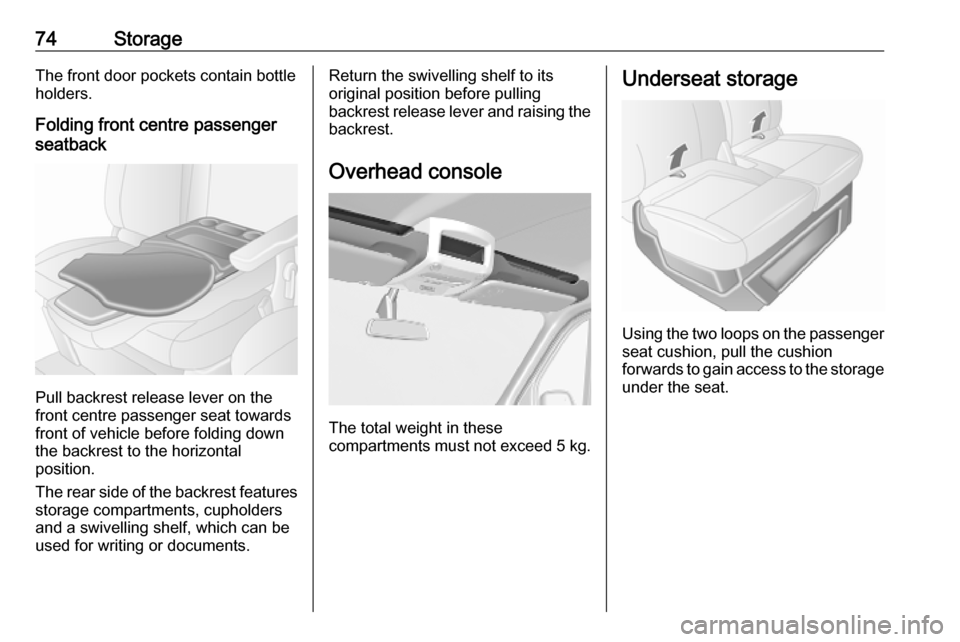
74StorageThe front door pockets contain bottle
holders.
Folding front centre passenger
seatback
Pull backrest release lever on the
front centre passenger seat towards
front of vehicle before folding down
the backrest to the horizontal
position.
The rear side of the backrest features storage compartments, cupholders
and a swivelling shelf, which can be
used for writing or documents.
Return the swivelling shelf to its
original position before pulling
backrest release lever and raising the
backrest.
Overhead console
The total weight in these
compartments must not exceed 5 kg.
Underseat storage
Using the two loops on the passenger
seat cushion, pull the cushion
forwards to gain access to the storage
under the seat.
Page 77 of 351

Storage75Rear bench seat
Raise seat base at front and remove
to gain access to storage
compartment under the bench seat.
Depending on model, bench seats
may also contain storage
compartments at the lower front part
of the seat and a storage net on the
outboard side of the seat.
Overcab storage
The total weight in this compartment
must not exceed 35 kg.
Rear storage
Combi, Bus
Objects can be stored in the overhead
storage compartments above the rear passenger seats.
The total weight must not exceed
20 kg evenly distributed.
Load compartment9 Warning
Always make sure that the load in
the vehicle is securely stowed.
Otherwise objects can be thrown
around inside the vehicle and
cause personal injury or damage
to the load or vehicle.
Use the grab handles, located beside
the rear and sliding side door(s), to
assist during entry and exit of the load compartment.
Page 83 of 351

Storage81Roof rack system
Roof rack For safety reasons and to avoiddamage to the roof, the vehicle
approved roof rack system is
recommended.
Follow the installation instructions
and remove the roof rack when not in
use.Loading information
● Heavy objects in the load compartment should be evenlydistributed and placed as far
forward as possible. If objects
can be stacked, the heavier
objects should be placed at the
bottom.
● Secure objects with lashing straps attached to lashing eyes
3 76.
● Secure objects into position or prevent loads from sliding
excessively by attaching optional cargo management features to
the load rails using removable
lashing eyes.
Cargo management system
3 77.
● Secure loose objects in load compartment to prevent them
from sliding.
● The load must not obstruct the operation of the pedals, parking
brake and gear selector lever, orhinder the freedom of movement of the driver. Do not place any
unsecured objects in the interior.
● Do not drive with an open load compartment. In addition, the
number plate is only
distinguishable and illuminated correctly if the doors are closed.9 Warning
Always make sure that the load in
the vehicle is securely stowed.
Otherwise objects can be thrown
around inside the vehicle and
cause personal injury or damage
to the load or vehicle.
● The payload is the difference between the permitted gross
vehicle weight (see identification
plate 3 314) and the EC kerb
weight.
To calculate the payload, enter
the data for your vehicle in the
Weights table at the front of this
manual.
The EC kerb weight includes
weights for the driver (68 kg),